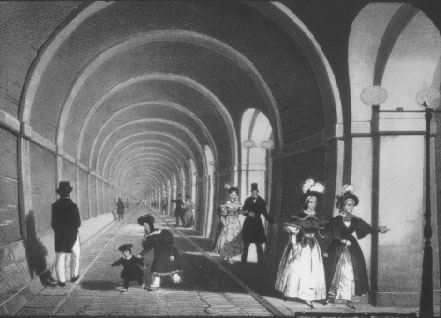The British Tunnelling Society is celebrating its 50th Anniversary and to mark it, they commissioned Award-winning British folk singer Nancy Kerr to create a mythical-industrial song cycle built from the “extraordinary stories of an indomitable international workforce which has shaped our land and waterways.”
“Not just the dates, and landmark projects, and prominent engineers, but the stories of all of us –
Dr Benoît Jones, British Tunnelling Society 2021
the hard work, humility, and sometimes hubris,
the everyday courage, and everyday fears,
the endless boring repetition when things go well,
the pressure, amidst the noise and dust, when they don’t.
The friends and colleagues we have lost or seen irreparably damaged. The ones who still stand by our sides.”
As Dr Benoît Jones highlights above, it’s easy to forget what those workers go through to bring us some of the remarkable civil engineering achievements of today and this new five-track EP titled Tunnellers, in the space of five tracks manages to both highlight and celebrate those achievements as well as bring a strong feeling of unity in its anthemic finale.
Kerr was, for a number of years, living on one such civil-engineering creation – the Kennet and Avon Canal. Before its construction, a pamphlet outlining its advantages promised a reduction in the price of “carriage of coals, and all other heavy articles” while the estates of gentlemen and farmers were to be tempted “free-stone, timber, brick, tile and other building materials; lime, peat-ashes and manure of all sorts. They will find new markets for the produce of their farms and estates: corn, malt, cheese and other productions, will meet with a ready and cheap conveyance to the great marts.”
Today they provide us something else – in an interview with Folk Radio last year Nancy mused about her time living on the canal: “One thing I found really poetic about the canal, having previously lived both in big cities and in wilder countryside, was how it straddles both these worlds – the waterway can be a slice of nature in the most urban concrete mass, or an industrial channel through the greenest places. I still set a lot of my songs in a space that has that tension of city versus wilderness.”
With that connection, she seems well placed to take on such a commission. Kerr is also a fine lyricist and that comes to the fore on Tunneller’s Hymn on which she pays tribute to the tunneller’s tenaciousness: from the industry’s Victorian heritage to a future that sees humans strengthen their global connections – to the benefit of all.
Novelist and cultural historian Peter Ackroyd wrote a fascinating book a few years ago titled ‘London Under’. A peek beneath the surface of the city into a hidden world which alongside streams, springs and Roman amphitheatres include numerous tunnels and civil engineering feats from sewers and train tunnels to catacombs and bank vaults.

Naturally, the book is filled with civil engineering wonders and some equally incredible and shocking revelations. Marc Brunel (son of Isambard) was responsible for the building of the 1,300 foot Thames Tunnel between 1825 and 1843 which was originally designed for horse-drawn carriages and later converted into a railway tunnel.
While it may have been a marvel of the Victorian age, it also had its fair share of horror stories inflicted upon the miners who did much of the work. This included flooding as well as old earth which was impregnated with foul gases described by one as ‘vomiting flames of fire which burnt with a roaring noise’. What is also surprising is that there was no science of underground engineering at the time – ‘Brunnel had merely copied the activity of a mollusc’ – more on this mollusc below which is celebrated in song and tune on Tunnellers. Similar machines are still in use in tunnelling today but thankfully we have organisations such as the British Tunnelling Society which among their roles is the promotion of ‘safe, efficient, sustainable, and technically advanced design, construction and use of underground space.’
On Tunnellers, Nancy Kerr finds inspiration from historic stories including those told in the BTS at 50 commemorative book. My Sweet Toredo is inspired by a mollusc, mentioned above, commonly referred to as shipworm whose burrowing technique inspired Marc Brunnel’s tunnelling technique. This shipworm is celebrated again in the sprightly uplifting Donegal highland tune and reel The Shipworm/The Shield.
There’s also touches of humour, Gettin’ a Rise which has a great chorus to join in on. Based on the old hop-picking song Hopping Down in Kent it is a shanty/slightly raucous playground rhyme that looks at the great physical demands made upon workers in the construction of the Dartford Tunnel.
Well we were feeling jammy
Gone down to 8-hour shifts
Then the foreman cries
You’ll be gettin’ a rise
Every time you take the lift!
The final track, Walk my Boots Clean, is an anthemic fitting finale on which the tunnellers are given a face – from Donegal to Eastern Europe.
For our crew, we’re the pick of the crowd
We are strong, we are bold, we are wild, we are proud
And from Brno to Bray, to the Wild Atlantic Way
We’ll walk our boots clean someday
Throughout, Nancy is joined by James Fagan, Tom A Wright and Matt Quinn. Nancy and the band have done a fantastic job, these five songs cover history, achievement, celebration and hardship. Excellent, as always.
Order via Bandcamp: https://nancykerr.bandcamp.com/album/tunnellers
Photo Credit: James Fagan

